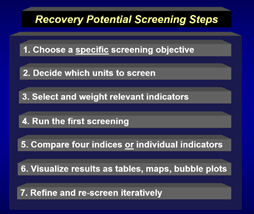The RPS Methodology: Comparing Watersheds, Evaluating Options
 If you want to assess and compare a group of watersheds or watershed-related units (e.g., HUCs) and plan for impaired waters restoration, healthy waters protection or other types of water resource management activities, this part of the website is for you. This methodology assumes your project will use the RPS Tool, a specially coded Excel spreadsheet that includes index calculation, rank ordering, graphing and mapping capabilities. The tabbed web pages below summarize the basic steps of Recovery Potential Screening and are cross-referenced to finer details in the website’s extensive RPS Tools, RPS Indicators, and RPS Training and User Support pages.
If you want to assess and compare a group of watersheds or watershed-related units (e.g., HUCs) and plan for impaired waters restoration, healthy waters protection or other types of water resource management activities, this part of the website is for you. This methodology assumes your project will use the RPS Tool, a specially coded Excel spreadsheet that includes index calculation, rank ordering, graphing and mapping capabilities. The tabbed web pages below summarize the basic steps of Recovery Potential Screening and are cross-referenced to finer details in the website’s extensive RPS Tools, RPS Indicators, and RPS Training and User Support pages.
These steps describe a tool, data and process for systematically comparing large numbers (tens, hundreds or even thousands) of watershed units at a selected scale. The RPS Tool is transparent and consistent in comparative assessment, but also very flexible. At many points, your own personal choices are required to customize the screening for your own geographic area, environment, sources of degradation and specific purpose at hand. Prospective users of RPS should note that screening can be done at very different levels of detail. Quick, informal comparisons on one’s desktop may be completed in minutes even at a statewide scale because of the pre-compiled watershed data and streamlined RPS Tool functionality. When more robust analysis is needed, it can be worth investing more time evaluating comparison options, adding your own data and selecting the most relevant indicators for a specific screening purpose. Each RPS step summary describes not only the mechanics of the RPS Tool but also the broader context for Tool use where the screening objectives, participants, indicators, analyses and outputs can be carefully planned and tailored to very specific circumstances.
